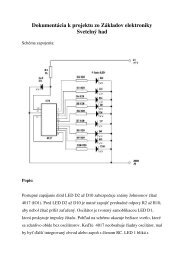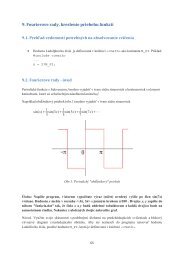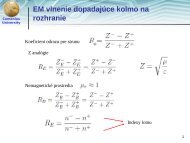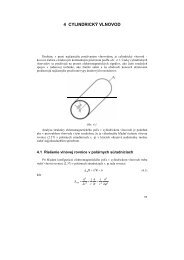Vlny a Optika
Vlny a Optika
Vlny a Optika
Create successful ePaper yourself
Turn your PDF publications into a flip-book with our unique Google optimized e-Paper software.
<strong>Vlny</strong> nekonečnej strunyFázová rýchlosťHustota struny na jednotku dĺžkySila napnutia struny v základnom staveRovinná vlna1
2),(),( ηξηηξξηξqttqt⎟⎠⎞⎜⎝⎛∂∂∂∂+∂∂∂∂=⎟⎠⎞⎜⎝⎛∂∂Hľadanie riešenia vlnovej rovnicenekonečnej strunyv-v),(),( ηξηηξξηξqxxqx⎟⎠⎞⎜⎝⎛∂∂∂∂+∂∂∂∂=⎟⎠⎞⎜⎝⎛∂∂
Rýchlosť modulácieStruna budená v bode x=0 signálom Z(t)Riešenie vlnovej rovniceModulácia4
Fourierov rozvoj inpulzu0∆t/2Tδω = ω1=2πTtf( t)∞ Aj= ∑δωcosj=0δωjδωtδω → dω7
Fourierov integrálδPre impulz na obrázku1.00.8∆t=10.6A(f)/A(0)0.40.20.0-0.2∆f=1/∆tAkú šírku v priestore bude mať rozruchvyvolaný impulzom?-0.4-0.6-0.8-1.00 1 2 3 4 5f∆t8
10Grupová rýchlosť vlnového balíka0))()cos((2))()cos((2),(00txkkAtxkkAtxqjnjnjnjnωωωωωω−−−++−+=∑∑∆∆
Disperzne prostredia11
Putovanie vlnového balíka12
Príklad – šírenie EM vĺn v ionosférePre nedispezné vlny (t.j. ω=vk pre všetky ω) sa tvar vlnového balíka nemení agrupová rýchlosť v g=v.Vo všeobecnosti ω=ω (k)V ionosféreIonosféra – 80 km nad povrchom zemeω p~10 MHz13
Grupová a fázová rýchlosť,disperziaH.J. Pain, THE PHYSICS OF VIBRATIONS AND WAVES, str. 13114
Rýchlosť signáluhttp://www.gap-optique.unige.ch/HomeExtras/PhysicsWebCausality.htmThis means, therefore, that neither the group nor the phasevelocity can be used to describe the speed at which theinformation in the pulse travels, and we need to define it byanother velocity - the "signal velocity". This is defined as thespeed at which the "front" of the pulse travels. According torelativity, this speed can never exceed the speed of light in avacuum because, if it did, it would be equivalent to sending thesignal backwards in time, which would violate causality.Grupová rýchlosť zodpovedá rýchlosti signálu len v neabsorbujúcich prostrediach.L.J. Wang, A. Kuzmich and A. Dogariu, Gain-assisted superluminal lightpropagation, Nature 406, 277-279 (2000). Their website,http://www.neci.nj.nec.com/homepages/lwan/gas.htm contains additional material,including an animation much like Fig. 4 of the present paper. (táto web stránka vsúčasnosti neexistuje)15
Záporná grupová rýchlosť a grupovárýchlosť väčšia ako rýchlosť svetlaL.J. Wang, A. Kuzmich and A. Dogariu,Gain-assisted superluminal light propagation,Nature 406, 277-279 (2000).Nicolas Brunner et al.,Direct Measurement of SuperluminalGroupVelocity and Signal Velocity in an OpticalFiber, Phys. Rev Lett. 93, 203902-1 (2004)16
Max Planck – Light str. 193We shall now fix our attention on the special case where the dispersive body,which we shall suppose stretches from x = 0 to x = ∞ is perfectly unexcited at firstand that from a certain, moment of time onwards, say t = 0, a singly periodic waveof frequency ω is continuously incident on its surface in the normal direction. Withwhat velocity will the disturbance propagate itself into the body? We may betempted to assume at first sight that the wave simply propagates itself into the bodywith the velocity c/n, as is the case with a permanently periodic wave. But this isnot so. For here we are concerned with a non-periodic wave which becomesdeformed as it advances. The complete solution of this problem has been given bySommerfeld, who resolved the waves into a Fourier integral. But we can find theanswer to the above question without making special calculations if we apply theline of reasoning which was fully discussed in § 86. The primary wave alsoadvances in the dispersive body with the velocity c. The secondary waves due tothe vibrating dipoles do the same. But the result of this joint action is not the sameas in the case of a permanently periodic wave.17
Planck – Light str. 193For the dipoles do not vibrate periodically; they were at rest initially and, on account of theirinertia, they will only gradually be made to vibrate, the later the greater their coordinate x,and these vibrations, strictly speaking, will acquire their constant character only after aninfinitely long period of time and so give rise to the singly periodic wave-motion whosevelocity of propagation is c/n. So long as this is not the case the primary wave will not beneutralized by the secondary waves and so it manifests itself as a disturbance which advancesin the dispersive body with the velocity c. Since on the other hand the secondary waves, nomatter what their form may be, also propagate themselves with the velocity c it follows thatthe desired velocity with which the head of the wave advances into the body, the " frontvelocity," is always equal to c. In contrast c with the front velocity is the " phase-velocity," -,which a permanently singly periodic wave has; in future we shall denote it by u : u=c/n. Wemust not regard it as an inherent contradiction to the theory that the phase-velocity u may alsobe greater than the front velocity c (n
Fourierov integrál v reálnom tvare19
FFourierov integrál v komplexnomtvare∞1f ( t)∫ F() e−iω td2−∞= ω ωπ∞∫−∞( ω )1( )2iωt= f t e dtπPozor na iné definície Fourierovho integrálu a Fourierových obrazov!!!!20
Impedancia prostredia021
Impedancia prostrediam=ρ∆x∆xzdroj03. Newtonov zákon22
Výkon dodávaný zo zdroja, tokenergie vlnenímBežiace vlnyAnalógia:Ak q je nábojP=ZI 2 =UI23
Rozhranie dvoch prostredíl il i+1q qq i+1i-1i∆x0Z+∂q+( x,t)∂t=Z−∂q−(x,t)∂t24
Odraz vlnenia opísaného vlnovoufunkciou Ψ na rozhraní dvochprostredí v 1DRTSpojitosť vlnovej funkcie26
Prispôsobovanie impedanciiΨ →=Ψ1Ψ12← =23← =RiAeRT1212( kx−ω)1 tiAee( −kRx−ω)1 tTik2Lik2Li(−k1x−ωt)23 21i2k2L12+ R23e=AeOdrazená vlna má byť rovná nuleΨ12 ←+ Ψ23←= 0e0Z 1Z 2Z 3x=0LxReálna časť=0Imaginárna časť=0ZZ11− Z+ Z22=ZZ22− Z+ Z33L =λ 2429
Pozdĺžne a priečne vlny - zvuk31
ZvukStredná voľná dráha musí byť oveľa menšia ako vlnovádĺžka ( l
0x∆x33
Pohybová rovnica∆x34
Newtonove odvodenie rýchlostizvuku – izotermické šírenie zvukuNewtonov modelExperiment35
Laplaceov adiabatický model šíreniasa zvuku36
Intenzita zvukuIntenzita zvuku – energia prechádzajúca cez jednotkovú plochu za jednotku časuReč zodpovedá asiJednotka intenzity zvukuPrach bolesti 100-1000 I z0Prach počuteľnosti 10 -10 I z0Ucho pracuje v logaritmickej mierkeAko citlivé sú naše uši?Sú schopné registrovať výchylky bubienka na úrovnirozmeru atómu37
Pozdĺžne a priečne vlny38
Lineárny kvadrupólový zdrojLaterálny kvadrupólový zdroj
Kmitanie dipólu a ladičky42









